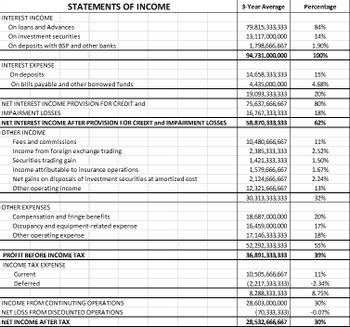STATEMENTS OF CONDITION ASSETS Cash and Other Cash Items Due from Bangko Sentral Ng Pilipinas Due from Other Banks Interbank Loans Receivable and Securities Purchased Under Agreements to Resell Financial Assets at Fair Value Through Profit or Loss Financial Assets at Fair Value Through Other Comprehensive Income Investment Securities at Amortized Cost, Net Loans and Advances, Net Assets Held for Sale, Net Bank Premises, Furniture, Fixtures and Equipment, Net Investments in Subsidiaries and Associates, Net Assets Attributable to Insurance Operations Deferred Income Tax Assets, Net Other Assets, Net Total Assets LIABILITIES AND CAPITAL FUNDS Deposit Liabilities Derivative Financial Liabilities Bills Payable and Other Borrowed Funds Due to Bangko Sentral ng Pilipinas and Other Banks Manager's Checks and Demand Drafts Outstanding Accrued Taxes, Interest and Other Expenses Liabilities Attributable to Insurance Operations Deferred Credits and Other Liabilities Total liabilities CAPITAL FUNDS ATTRIBUTABLE TO THE EQUITY HOLDERS OF BPI Share capital Share premium Treasury shares Reserves Accumulated other comprehensive loss Surplus NON-CONTROLLING INTERESTS Total capital funds Total liabilities and capital funds 3-Year Average Percentage 37,310,666,667 1.54% 225,228,333,333 9.31% 39,972,333,333 1.65% 24,495,000,000 1.01% 26,892,333,333 1.11% 120,064,666,667 4.96% 334,619,333,333 14% 1,528,976,666,667 63% 3,337,666,667 0.14% 18,570,666,667 0.77% 7,300,666,667 0.30% 18,449,666,667 0.76% 16,698,666,667 0.69% 17,856,333,333 0.74% 2,419,773,000,000 100% 3-Year Average Percentage 1,922,441,666,667 79% 4,528,666,667 0.19% 114,829,666,667 4.75% 1,777,000,000 0.07% 6,931,333,333 0.29% 9,300,666,667 0.38% 14,169,333,333 0.59% 46,822,333,333 1.93% 88% 2,120,800,666,667 46,456,333,333 1.92% 84,607,000,000 3.50% (11,014,333,333) -0.46% 541,333,333 0.02% (9,608,333,333) -0.40% 185,890,333,333 7.68% 296,872,333,333 12% 2,100,000,000 0.09% 298,972,333,333 12% 2,419,773,000,000 100%
Reporting Cash Flows
Reporting of cash flows means a statement of cash flow which is a financial statement. A cash flow statement is prepared by gathering all the data regarding inflows and outflows of a company. The cash flow statement includes cash inflows and outflows from various activities such as operating, financing, and investment. Reporting this statement is important because it is the main financial statement of the company.
Balance Sheet
A balance sheet is an integral part of the set of financial statements of an organization that reports the assets, liabilities, equity (shareholding) capital, other short and long-term debts, along with other related items. A balance sheet is one of the most critical measures of the financial performance and position of the company, and as the name suggests, the statement must balance the assets against the liabilities and equity. The assets are what the company owns, and the liabilities represent what the company owes. Equity represents the amount invested in the business, either by the promoters of the company or by external shareholders. The total assets must match total liabilities plus equity.
Financial Statements
Financial statements are written records of an organization which provide a true and real picture of business activities. It shows the financial position and the operating performance of the company. It is prepared at the end of every financial cycle. It includes three main components that are balance sheet, income statement and cash flow statement.
Owner's Capital
Before we begin to understand what Owner’s capital is and what Equity financing is to an organization, it is important to understand some basic accounting terminologies. A double-entry bookkeeping system Normal account balances are those which are expected to have either a debit balance or a credit balance, depending on the nature of the account. An asset account will have a debit balance as normal balance because an asset is a debit account. Similarly, a liability account will have the normal balance as a credit balance because it is amount owed, representing a credit account. Equity is also said to have a credit balance as its normal balance. However, sometimes the normal balances may be reversed, often due to incorrect journal or posting entries or other accounting/ clerical errors.
E.x.p.l.a.i.n. .t.h.e. .3.-.y.e.a.r. .a.n.d. .t.h.e. .p.e.r.c.e.n.t.a.g.e. .o.f. .a. .F.i.n.a.n.c.i.a.l. .P.o.s.i.t.i.o.n. .o.f. .t.h.e. .c.o.m.p.a.n.y. .a.n.d. .g.i.v.e. .a. .c.o.n.c.l.u.s.i.o.n. .o.f. .i.t.

Step by step
Solved in 3 steps

E.x.p.l.a.i.n. .t.h.e. .3.-.y.e.a.r. .a.n.d. .t.h.e. .p.e.r.c.e.n.t.a.g.e. .o.f. .a. .I.n.c.o.m.e. .S.t.a.t.e.m.e.n.t. .o.f. .t.h.e. .c.o.m.p.a.n.y. .a.n.d. .g.i.v.e. .a. .c.o.n.c.l.u.s.i.o.n. .o.f. .i.t.









